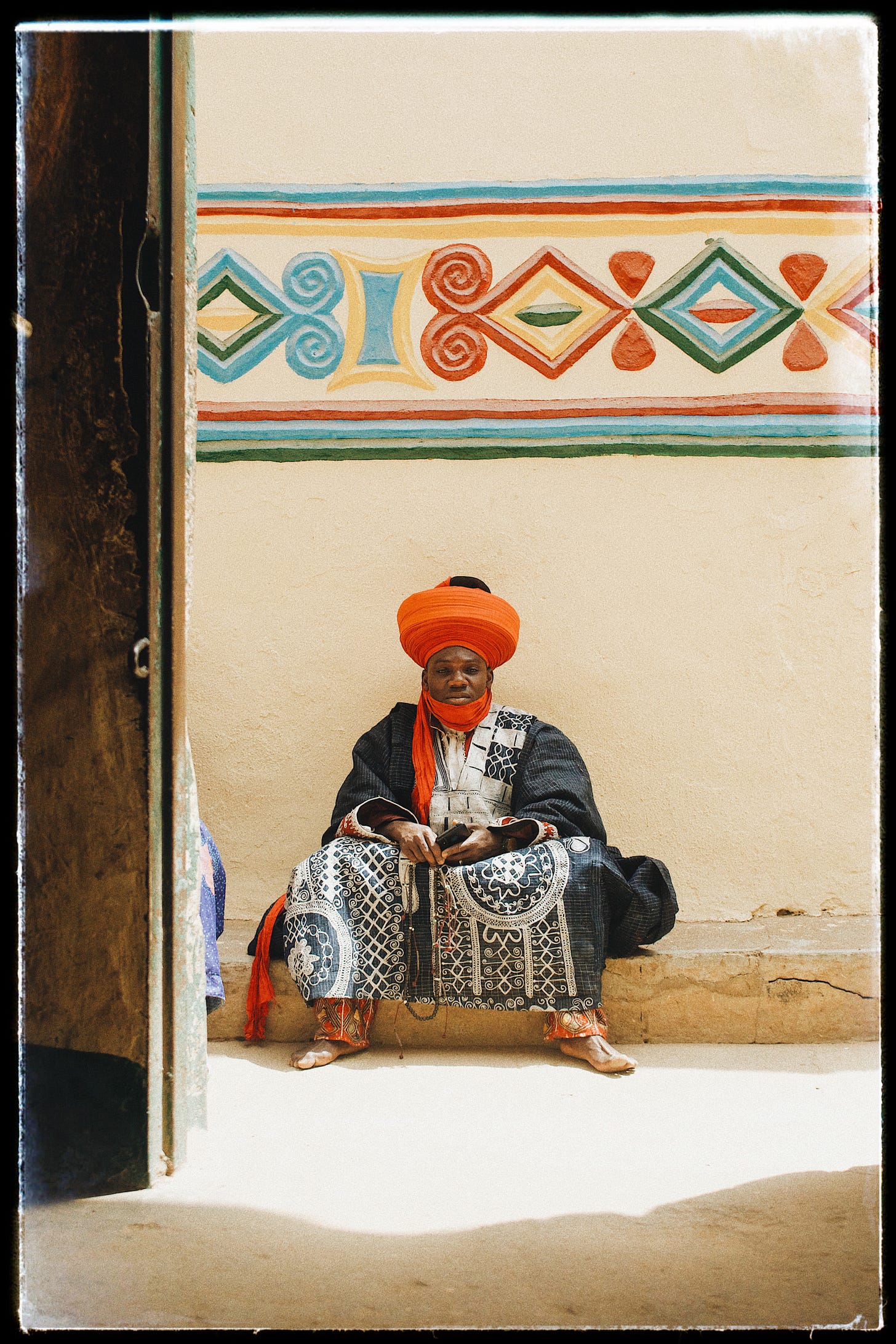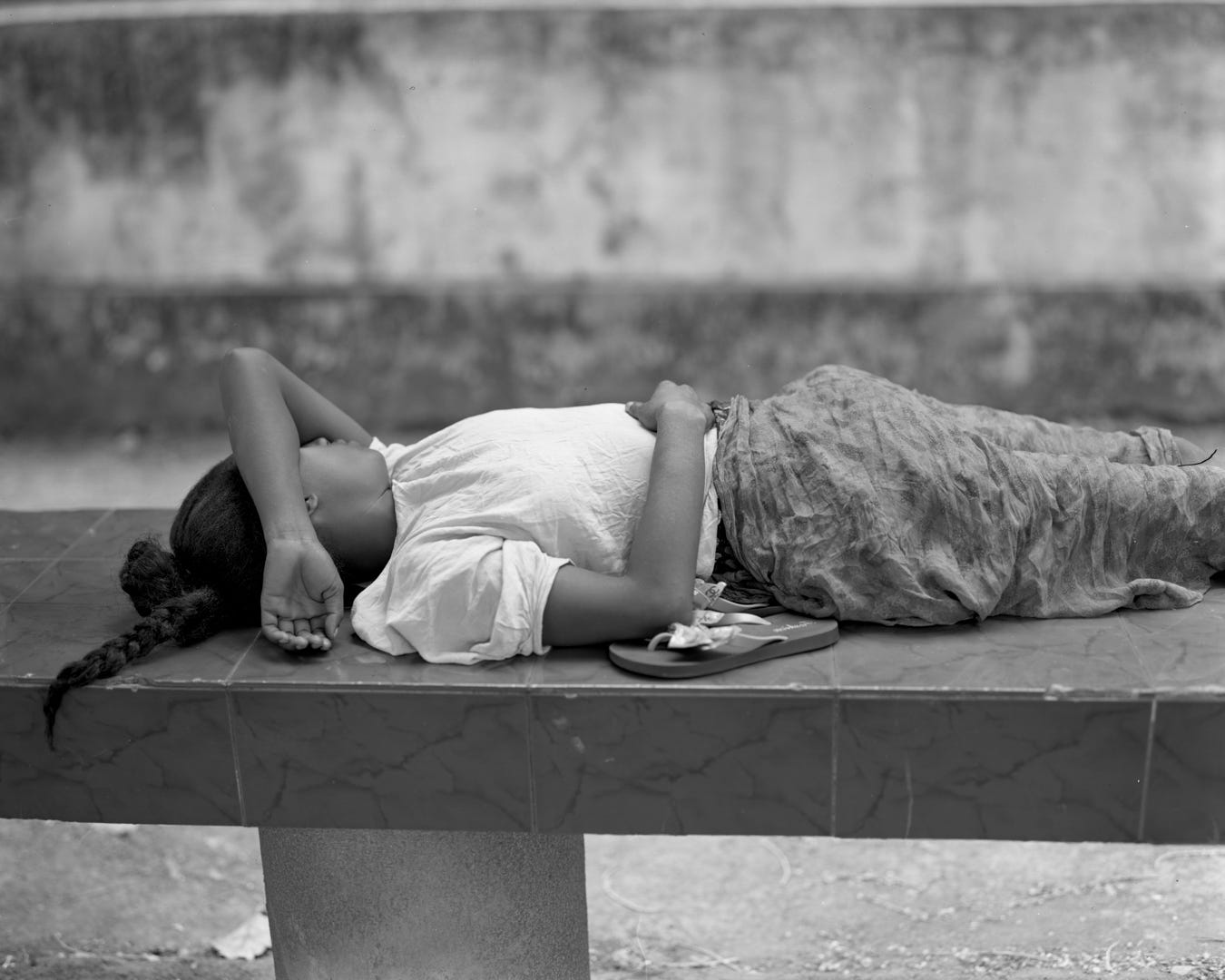First the blue, then the satin. You notice the resplendent flow of the gown, the stately poise of its wearer, an easy fit. She’s standing next to a rubble of stone, the line on the wall behind her as subtle a reminder of fragility as the castaway footwear. You also notice the hint of a toe, like a gentle prod toward you, with the same casual nudge as her gaze—the unflinching mindfulness of adolescence.
— Emmanuel Iduma
“Photographing my family is a way for me to establish a unique exchange.”
This photo was taken at my family home in M'bour, Senegal, during the Tabaski celebration. Tabaski is an annual Muslim religious celebration where the family gathers around a meal made from sheep. It’s a moment of togetherness, where everyone wears their finest festive clothes.
On that day, I celebrated Tabaski with my family, camera in hand, enchanted by the beauty of the outfits, the colors, the textures... and very happy to share the joy of the children being photographed in their best clothes. Everyone embraced the moment, in an atmosphere filled with beauty and warmth.
After the meal, the day quieted down. The sun was blazing, and the time for a nap gradually settled in, before everyone got ready to go out again, dressed in their second outfits, to visit neighbors.
In the shade of the mango tree outside the house, I suddenly noticed my young cousin Bollo, stepping out alone, wearing a gorgeous long blue satin dress. Time seemed to stand still. Too impatient to wait for the elders to wake up, she had already changed, eager to proudly show me her outfit.
I was immediately struck by her grace and offered to take her picture. I positioned her against the wall of the family home. On the other side of that wall was my grandmother’s room, who had passed away a few years ago.
At that precise spot, there was a pair of blue flip-flops lying on the floor. We burst into laughter, as she found them ugly, while I adored them.
This photograph is part of my project “NAATAL” ("images" in Wolof), a photographic project in which, through the exploration of my own family history, I seek to understand the role of photography in preserving memory and shaping individual and collective black identities.
I chose this image because it embodies many of the themes that run through my work and feed my sensitivity as a photographer. Photographing my family is a way for me to establish a unique exchange, to invite a moment suspended through the act of photography. It creates a different, intimate dialogue that emerges from this process.
Since childhood, I have been fascinated by colors, textures, and materials, an attraction rooted in my diverse origins. When I’m in Senegal, I reconnect with these deep inspirations that accompany me daily, like echoes of my cultural identity. They naturally surface in my work.
Inspired by my French and Senegalese family heritage, I attempt to explore this cultural hybridity in an intimate way, asking the question of re-appropriating representations of black identities. I am deeply drawn to the ideas of representation through photography, guided by a sensitive and emotional approach. Exploring notions of identity is at the heart of my artistic journey, constantly shaping and inspiring my creative expression. I like to incorporate photographic archives in my work. I’m drawn to the emotional connections we form with images in private spaces and the people they portray. I collect family photographs, often tucked away in closets, under beds, images that rarely resurface. These forgotten snapshots bring up questions about preserving archives and collective memory.
What I particularly appreciate in this photograph is the beauty of the unexpected, the fleeting moment. Nothing was staged, yet one could believe the image was carefully composed. It’s this element of spontaneity, this moment of grace that appears without warning, that I love to capture. Each photograph becomes a fragment of everyday life, a snapshot of time frozen.
— Yama Ndiaye
About Yama Ndiaye
Yama Ndiaye is a French-Senegalese photographer. Born in Paris with a painter father and a visual artist mother, she was immersed from an early age in a colorful universe. She graduated in June 2023 from the Gobelins School of Photography in Paris and won the 1st Grand Prize at the Picto Fashion Photography Awards a year later. This recognition places her among the laureates of this prestigious award, which honours artists and future key figures in the worlds of art and fashion. More of her work can be found through features in Picto Foundation and Harpers Bazaar, as well as on Instagram.
RELATED — “Turban and Mural” by Abdullahi Ahmad
When I approached the subject, I began with greetings, followed by a few jokes, and then I asked if I could take a picture of him because I liked his clothes, which he confidently agreed to.
LAST WEEK — “Place de la Musique” by Jean Luc Andrianasolo
We stopped by the Place de la Musique, which is more of a small park with an old kiosk from the French colonial era. While there, we passed by a girl sleeping. I loved the way she slept because it reminded me of my friend who has the same sleeping posture. I suppose many people sleep that way. I remember taking a similar picture in a park in Antananarivo.
This is the 135th edition of this publication. The newsletter also read on web (best for viewing images), and via the Substack iOS/Android apps.
TENDER PHOTO is a collaborative digital archive and publishing platform of contemporary African photography, edited by Emmanuel Iduma. Our aim is to use photography to engage with life on the African continent. We publish narratives about the people, places, and events pictured in photographs, contributing to nuanced and layered perceptions.
Every Wednesday we feature a photograph, a short caption about it, and a statement from the photographer. Last year, we published commentaries or photo-essays in response to photographs previously featured on the newsletter, including CORRESPONDENCES, CONCORDANCE, KINDRED, INDEX, and AFFINITIES. Our recent Friday series was dedicated to the 5 photographers featured in Process Projected, Amsterdam.
Thank you for reading. If this newsletter was shared with you, consider subscribing, or forward to a friend. Please whitelist the newsletter to ensure you never miss it.






That turban and mural pic is gorgeous
I always look forward to these, and I especially love the image in this one.